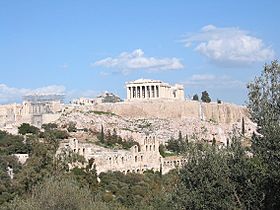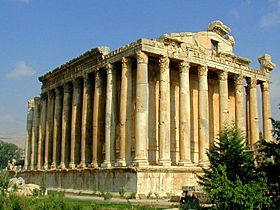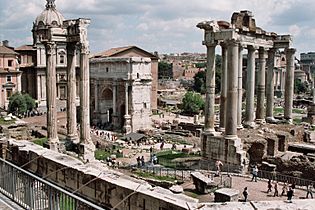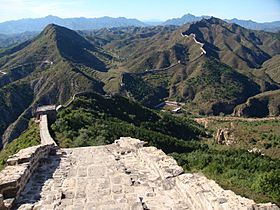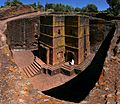Civilization facts for kids
Civilization comes from the Latin word civis, which means someone who lives in a town. When people are civilized, they live in large, well-organized groups. They do not live in small tribes or isolated family groups.
A civilization is more than just a town. It is an advanced way of living together. This means it has laws, a shared culture, and a regular way to get food. It also has ways to protect its people. Most civilizations use farming to get food. They also have a system of government, like monarchs (kings or queens) or elections. People in a civilization usually speak a common language. They often share a religion too. They teach their young people the knowledge they need to live. All civilizations since the Sumerians and the Egyptians have used some kind of writing. Writing helps people store and build up knowledge over time.
Famous Civilizations
The Roman Empire
The Roman Empire is a great example of a large civilization. It was ruled from the city of Rome. This empire once stretched from the borders of Scotland all the way to North Africa. It also reached across the eastern Mediterranean Sea. The Romans had their own language, Latin.
Latin became the main language for educated people. It was used long after the Roman civilization ended. Even today, lawyers, doctors, scientists, and scholars still use Latin words. This is true even though the Roman civilization disappeared over 1,500 years ago. Famous writers like William Shakespeare were very good at Latin. Latin is still taught in some schools today.
We still admire and copy Roman architecture. We use Roman numerals to count certain things. We use the names of Roman gods for our days and months. The constellations in the sky still have the names the Romans gave them. Our Western political systems are also based on Roman ideas. Words like Senate, Governor, election, justice, and vote all come from Latin. Their meanings have not changed in thousands of years.
The Roman civilization lasted almost 1,000 years. However, the Ancient Egyptian civilization was even older. It lasted for a much longer time. The Romans and Egyptians fought each other in the Battle of Actium. Rome won this battle, and Egypt became part of the Roman Empire.
- Examples of civilizations
-
The Temples of Baalbek in Lebanon. They show styles from many influential civilizations. These include the Phoenicians, Babylonians, Persians, Greeks, Romans, Byzantines, and Arabs.
-
The Roman Forum in Rome, Italy. This was the main center of the Ancient Rome civilization. Its ruins are still visible today.
-
The Great Wall of China was built to protect ancient Chinese states. Over thousands of years, China was home to many important civilizations.
-
Ancient Egypt is a classic example of an early civilization.
What Makes a Civilization?
A civilization is a very advanced stage of human society. It shows great progress in many areas.
- Learning and Culture: People develop new ideas in art and science. They also have good manners and ways of behaving.
- Record Keeping: Civilizations use ways to keep records, like writing. This helps them store information.
- Organized Society: They have complex political and social systems. This means they have governments and different groups of people working together.
A civilization can also describe the type of culture and society found in a certain place or time. For example, we talk about the Mayan civilization or the civilization of ancient Rome. It also refers to the process of becoming civilized. When we say "We returned to civilization after camping," it means we came back to modern society with its comforts.
Images for kids
-
The Acropolis of Athens: Athens is often called the cradle of Western civilization. It is also the birthplace of democracy.
-
The End of Dinner by Jules-Alexandre Grün (1913). Table manners and other forms of etiquette are seen as signs of a civilized society.
-
Depiction of united Medes and Persians at the Apadana, Persepolis.
-
The ruins of Mesoamerican city Teotihuacan.
-
A world map of major civilizations. This map is from the idea called Clash of Civilizations by Samuel P. Huntington.
-
The pyramids of Giza are famous symbols of the civilization of ancient Egypt.
-
The Persepolis in Iran: Pictures of the Gate of All Nations. This was the main entrance for visitors from other states.
-
The Roman Forum in Rome, Italy. This was the political, economic, cultural, and religious center of the Ancient Rome civilization.
-
The Ziggurat of Ur in Iraq. Ziggurats are iconic monuments of ancient Mesopotamian civilization.
-
The Great Wall of China was built to protect ancient Chinese states. Over thousands of years, China was home to many influential civilizations.
-
Machu Picchu in Peru is the most recognizable symbol of the Inca civilization. It is one of the New 7 Wonders of the World.
-
El Castillo, at Chichen Itza. The Maya civilization was known for its advanced writing system. They also had amazing art, architecture, mathematics, calendar, and astronomical systems.
-
Notre-Dame de Paris in Paris, France. It is a symbol of the civilization of Christendom. Western civilization is strongly influenced by Greco-Roman and Christian cultures.
-
Hagia Sophia in Istanbul, Turkey. This building is an icon of Byzantine and Eastern Orthodox civilization.
-
The Round city of Baghdad was founded in 762–766 CE. It became the capital of the Abbasid Caliphate. This led to the Islamic Golden Age.
-
Borobudur in Indonesia is the world's largest Buddhist monument. It represents the Javanese empire of Mataram kingdom.
-
Saint Basil's Cathedral in Moscow. It is a popular icon of Russian civilization.
-
Angkor Wat in Cambodia is the largest religious structure ever built. It represents the Khmer Empire, a very influential civilization in Southeast Asia.
-
Nineveh was an ancient Assyrian city. The Assyrian civilization was known for its sculpture, architecture, and astronomy.
-
Lalibela churches; popular icons of Ethiopia. They represent the legacy of the Kingdom of Aksum, a Classical African civilization.
See also
 In Spanish: Civilización para niños
In Spanish: Civilización para niños



